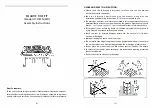
Hearthstone
Clydesdale Fireplace Insert Model 8491
Page 24 of 35
chimney, emits the lowest amount of pollutants, but
provides shorter burn times.
Medium to Medium Low Burn Rate:
In general, you
would usually create a medium to medium low burn
rate, especially if your stove is left unattended
periodically. Set the primary air control to a mid-range
setting, appropriate to maintain a comfortable
temperature in the heated area. This setting
produces the most efficient overall burn.
Low Burn Rate:
Close the primary air control for a
low burn rate. This setting provides the longest burn
time. However, set a low burn rate only periodically.
Over extended periods of time, a low burn rate
promotes the accumulation of creosote. If you
consistently maintain low burn rates, inspect your
venting system frequently.
Overnight Burn Rate:
An overnight burn, as you
might expect, allows you to keep an area heated
while you sleep. To create an overnight burn, first
ensure the stove and chimney is hot from an
established fire. Next, pull the primary air control fully
open, and then completely load the firebox with
wood. Allow the fire to burn intensely for 20 to 30
minutes.
Finally, push the primary air control
close to
its lowest
setting; the fire will settle into a lower burn rate with a
small flame and more secondary gas ignition. The fire
will now burn slowly and steadily. The longevity and
intensity of the fire depends on the type, size and
quality of the wood, the strength of the chimney draft,
and other variables which vary from installation to
installation. High draft installations or situations may
require using a low burn rate setting.
In the morning, you should find a bed of hot coals
buried within the ashes. The insert should be warm to
the touch but not hot. To restart the fire without
relighting, simply stir and rake the ashes with a poker
until the hot coals have come to the surface. Place a
handful of kindling and a few small logs on the coals,
close the door, and fully open the primary air control.
The fire should re-ignite within 5 to 10 minutes. Once
the fire is burning well, add a few larger logs, close
the door, leave the primary air control fully open, and
allow the fresh logs to ignite.
Running a high burn rate at least once a day burns
off accumulated creosote from within the insert and
venting system. Now, in the morning after an
extended low burn rate, is a good time to create your
daily high burn rate; run it for about 20 minutes or so.
Not only does this hot fire promote a clean stove and
chimney, it also helps keep the glass cleaner for easy
viewing of the fire within.
Once the fire is burning briskly, regulate the primary
air control to a medium setting for a medium to
medium low burn rate.
Intermittent Operation
If your Fireplace Insert is not used continuously or
has not been used in quite some time, follow the
break-in procedure at least once to minimize the
stress of a hot fire on a cold Fireplace Insert before
proceeding with normal operation. We recommend
one break-in fire at the start of each heating season.
Building a Fire for Everyday Use
1. Open the front door and place five or six double
sheets of tightly twisted newspaper in the center
of the firebox. Arrange kindling in a crisscross
pattern over the newspaper. Use about ten
pieces of kindling approximately 1/2" (13 mm) in
diameter and 10" to 18" (254 to 457 mm) long.
You can place two or three small logs on top of
the kindling if desired.
2. Fully open the primary air control by pulling the
control handle fully out, away from the firebox.
3. Light the paper under the kindling. Leave the
front door slightly ajar until the kindling starts to
burn and draft begins to pull.
4. Close the door and allow the fire to burn.
5. If you did not add small logs in step 1, do so once
the kindling is burning well. Open the front door
and add small logs. Ensure you keep the logs
away from the glass in front in order for the air-
wash system to work properly. Otherwise, keep
the door closed while the insert is in use.
6. Once the fire is burning well, add larger wood
pieces to build the fire up. Use the primary air
control to regulate the desired rate of burn. Pull
the handle out to open the PRIMARY AIR
CONTROL for a high rate of burn; push it in to
reduce the primary air for a lower rate of burn.
Note:
When opening the front door to reload
or re-arrange logs, open the door just a crack
first, pause for a moment, then open the door
completely. This procedure allows the firebox
to clear of smoke before the door is opened
fully. Also, reloading on a bed of hot, red
coals reduces smoking time and will bring
fresh fuel up to a high temperature rapidly.












































